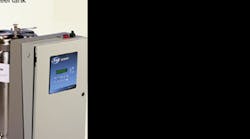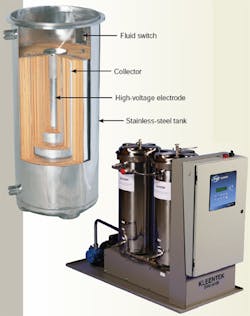Oxidation is inevitable as hydraulic systems run, and where there is oxidation, there is going to be varnish if it’s not prevented. If varnish gets on hydraulic servo, proportional, and cartridge valves, friction will increase, thus causing loss of control stability, increased downtime, and other problems.
To alleviate these potential problems, the Kleentek System’s electrostatic cleaner removes all insoluble contaminants from hydraulic oils, including those that can cause varnish. It actually cleans the internal surfaces of the system, stripping away varnish one molecule at a time.The most critical components in the Kleentek system are two stainless-steel tanks that house the system’s filtration element. These high-capacity collection elements provide operation to 8000 hr. An electrode provides a high-voltage charge, a high-capacity collector uses multiple cleaning fields for optimal varnish removal, and a fluid switch monitors oil level to activate controls.
By using gradient force, the system takes advantage of the natural charge that each contaminant contains. Contaminants with a positive charge are drawn toward a negative electrode within the center of the collector, while those with inherent negative charge are drawn toward a grounded surface on the outside of the collector.
The system taps into a hydraulic system as a kidney loop to draw oil from a main reservoir and circulate it at low velocity for continuous removal of contaminants from hydraulic fluids. Each system includes a positive displacement gear pump that regulates oil flow and a fully-enclosed, fan-cooled
14-hp motor.
The DOC-N100 is the largest capacity model, with the largest cleaning chamber and flow rates. Other models available include the DOC-R3, DOC-N10, DOC-S10, DOC-N25, DOC-S25, and DOC-N50.
Make contact:
UAS Kleentek
Cincinnati, OH
(513) 891-0400
www.kleentek.com
| Specification ranges for seven models | |
| Cleaning Chamber Capacity: | 0.79 to 18.48 gal |
| Flow rates: | 0.25 to 5.5 gpm |
| Width: | 11.1 to 20.75 in. |
| Length: | 14 to 43.25 in. |
| Height: | 26.15 to 33.25 in. |
| Weight: | 42 to 270 lb |


